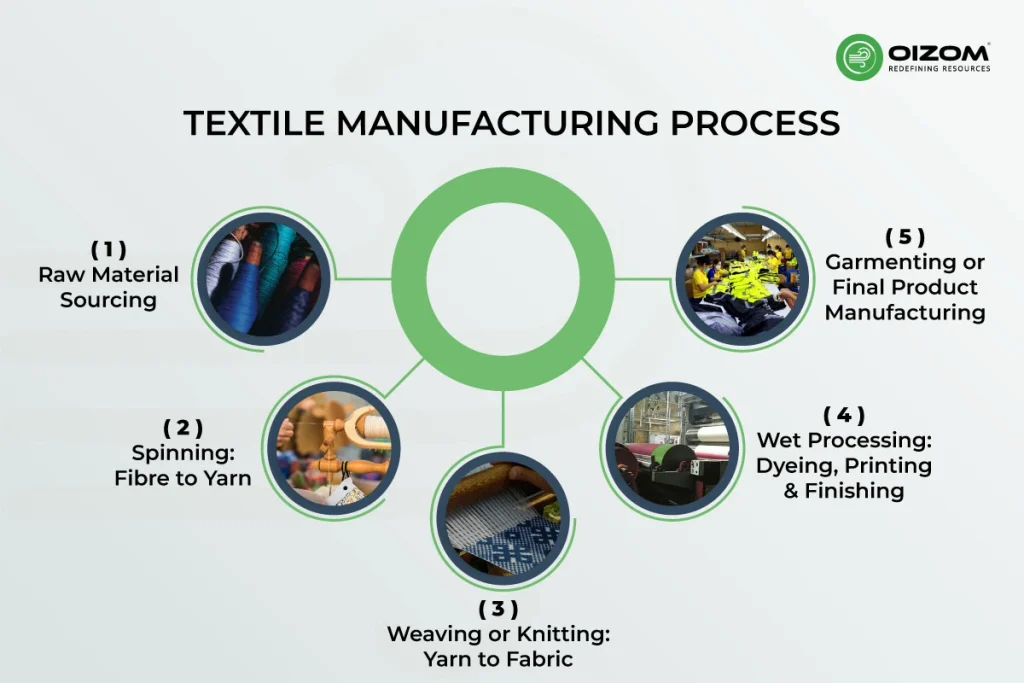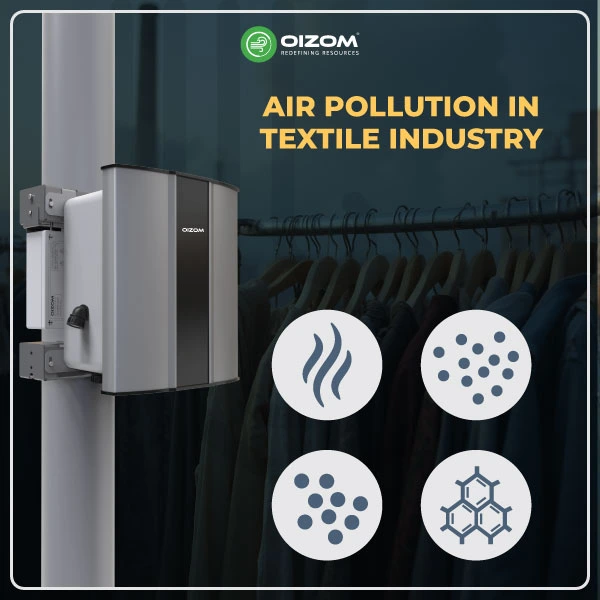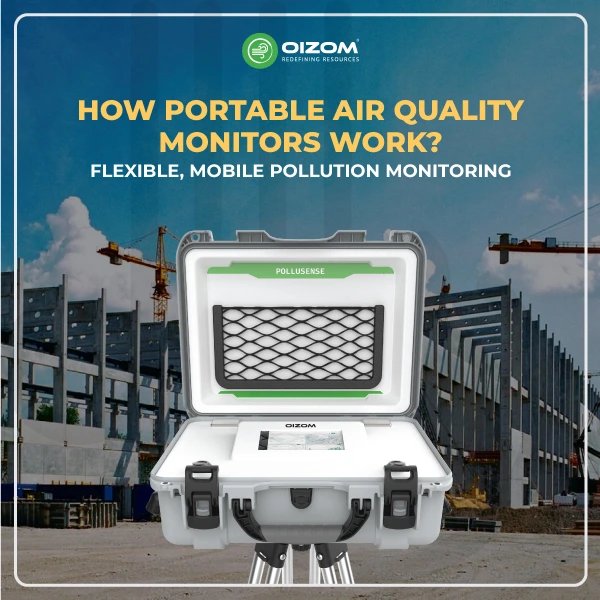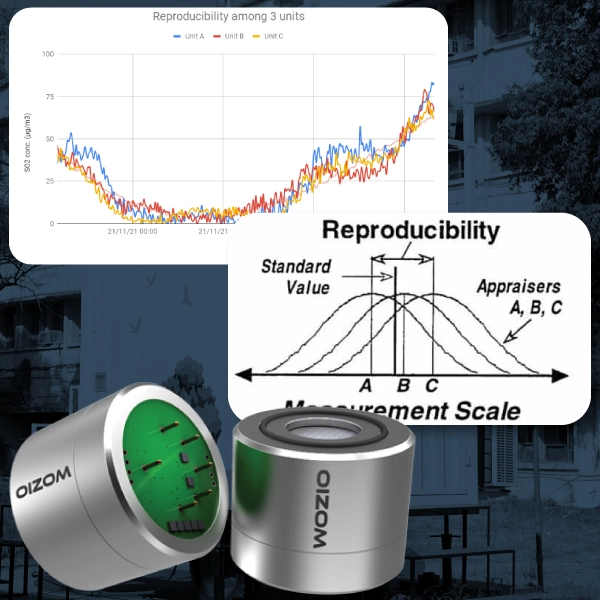Summary
From garment assembly lines in Bangladesh to the dyeing units of Ahmedabad, the textile industry spans across the world. The textile industry closely connects and influences jobs, economies, and emissions. While its effect on water contamination is often highlighted, its contribution to air pollution is relatively less discussed. Behind every T-shirt or pair of jeans lies a trail of invisible emissions: a single pair of denim, for example, can emit up to 33.4 kg of CO₂ equivalent gases during its lifecycle.
Air pollution in the textile sector stems from fuel-burning boilers, VOC emitting dyes, and chemical-laden finishing processes, all of which affect not just the environment but also workers and surrounding communities. Rising textile hubs like Ludhiana, Tiruppur, and Ahmedabad are leading to air quality decline in their surroundings.
With fast fashion becoming a trend, the demand for textile goods has risen. Hence, the need to confront these emissions has become urgent. Solutions such as cleaner production technologies, waste utilization, and real-time emission tracking exist, but only if the industry chooses to look beyond fabric and focus on the air we share.
So the question arises: will fashion tame its own fumes?
Air Pollution in Textile Industry
Discussions around textile industry pollution often revolve around how the dyes contaminate water, water consumption, and the removal of apparent color. However, the air quality concern is often overlooked. But what often goes unnoticed is the extent to which textile manufacturing pollutes the air we breathe. From cotton farming to the clothes we wear, each stage of textile production releases harmful emissions, including toxic gases, chemical vapors, and fine particulate matter.
Today, the textile industry is valued at nearly $1 trillion globally and continues to grow. To meet this demand, factories operate nonstop, relying on energy-intensive fuels and processes. Often involving combustion, boilers, dyes, and chemical finishes, all of which contribute to air pollution. In places like the Atacama Desert in Chile, discarded fast fashion has created textile graveyards where burning waste releases toxic fumes into the sky. Closer to home, workers in dense textile zones breathe in formaldehyde, VOCs, and dust daily, leading to chronic health risks.
And yet, these emissions rarely get the spotlight. We at Oizom believe it’s time to change that. After all, do you really know how much pollution your favorite shirt caused before it made it to your closet?
Textile Manufacturing Process
Textile manufacturing involves a complex, step-by-step process that turns raw fibers into finished fabrics and into required final products like garments or home textiles. The exact output of a manufacturing unit depends on how integrated it is. However, most textile facilities broadly follow these core stages:

1. Raw Material Sourcing
Textile production starts with the cultivation or synthesis of fibers, depending on the nature of the fiber required:
Natural fibers like cotton, wool, silk, jute, hemp, etc. are primarily derived from plants and animals.
Synthetic fibers, including polyester, nylon, acrylic, and spandex, are derived from petrochemicals.
2. Spinning: Fibre to Yarn
This process is also known as yarn manufacturing, turning raw materials into yarn. Firstly, the fibers are cleaned, combed, and spun into yarn, which is fundamental to fabric production. Spinning is done using machines with steel bobbins known as roving, some machines can also “twist” in order to add strength and elasticity to the final product.
3. Weaving or Knitting: Yarn to Fabric
Once yarn is ready, it is either woven or knitted into fabric. Here, yarn is taken from one machine and fed into another machine to create a length of fabric. Once the length of textile fabric is created, it is removed from the looms and then sewn together to create a finished product. This fabric at this stage is raw and unprocessed, known as greige (gray) fabric.
4. Wet Processing: Dyeing, Printing & Finishing
Depending on the need and usage, the greige fabric undergoes wet processing, including dyeing, printing, and chemical finishing. The dyeing process involves the application of colorants to fabric in order for it to become colored. Overall, these processes enhance the fabric’s color, texture, and functional properties (e.g., wrinkle resistance, water repellency).
5. Garmenting or Final Product Manufacturing
Many units also convert finished fabrics into garments and textile goods. Garment manufacturing usually involves processes such as garment design, pattern making, and sample making. These units handle cutting, stitching, inspection, and packaging.
What Causes Air Pollution in the Textile Industry?
Textile manufacturing involves multi-stage processes, which involves spinning, weaving, knitting, dyeing, printing, finishing, and packaging. And every stage somehow uses fuels, chemicals, and machinery that can potentially pollute the air.
Major air pollution sources include
Boilers & fuel combustion: Boilers are used to generate steam and hot water for dyeing, printing, and drying fabrics, and sometimes for humidification. In this process, they emit SO2, NOx, CO, and PM2.5 from coal or furnace oil use
Dyeing & bleaching: Release chlorine gas, hydrogen sulfide, and aniline vapours.
Printing & finishing: Emit volatile organic compounds (VOCs), formaldehyde, ammonia, etc.
Mechanical processes: Spinning and weaving release fine textile dust and fibers.
Impact of Air Pollution caused by Textile Industry
1. Environmental Impacts
Air Quality Degradation: Pollutants and gases such as volatile organic compounds (VOCs), particulate matter (PM), sulphur dioxide (SO₂), nitrogen oxides (NOx), and formaldehyde pollute the local air.
Greenhouse Gas Emissions: Dyeing, drying, and printing processes are highly energy-intensive and water-consuming in nature, they release CO₂ and methane in significant amounts, contributing to climate change.
Smog and Ground-Level Ozone: VOCs and NOx can react in sunlight to form ozone and photochemical smog, which harms ecosystems and visibility.
Acid Rain Formation: SO₂ and NOx can lead to acid rain, harming aquatic life and crops.
2. Health & Social Impacts
Respiratory Issues: Workers and people from nearby communities are at risk of asthma, bronchitis, and chronic obstructive pulmonary disease (COPD) due to inhaling fine particles and gases.
Long-Term Risks: Prolonged exposure to VOCs (like benzene and toluene) can lead to cancer, neurological disorders, and organ damage.
Vulnerable Groups Affected: Children, elderly people, and pregnant women are particularly susceptible to pollution-related health issues.
3. Economic Impacts
Healthcare Costs: An Increase in illness leads to increased medical expenses, loss of productivity, and pressure on public health systems.
Workforce Downtime: Polluted working environments affect labour efficiency, increased sick leaves, and high employee turnover in textile zones.
Global Compliance: Globally, buyers are now preferring eco-friendly products. Polluting units risk losing business or facing export restrictions.
Infrastructure Damage: Acid rain and pollutant buildup can corrode machinery and damage buildings, increasing maintenance costs.
4. Regulatory & Legal Impacts
Non-compliance Penalties: Governments are implementing air pollution regulations where non-compliant factories risk fines, closures, or license suspension.
Net-Zero Mandates: Demand for cleaner supply chains has been increasing, pushing the textile sector to reduce emissions.
Key Pollutants can be Categorised as:
Primary Pollutants: VOCs, chlorine gas, flue gases.
Photochemical Precursors: Chlorine radicals, other reactive intermediates.
Secondary Pollutants: Halogenated VOCs, HCl, smog components.
Strategies to Reduce Air Pollution in the Textile Industry
1. Adopt Cleaner Production (CP) Practices
Cleaner Production is a preventive, holistic approach focused on reducing pollution at the source. Textile-focused CP methods include raw material substitution, process optimization, and waste minimization.
Example: A weaving mill in Bursa applied sustainable production improvements, cutting energy consumption by 17.1% and CO₂ emissions by 13.5%
2. Switch to Cleaner Fuels
Transitioning from coal or oil to cleaner options like natural gas, biomass, or electricity significantly lowers emissions of SO₂, NOx, PM, and CO₂ (indirect from energy generation) .
For instance, replacing coal with natural gas or biomass in boilers can sharply cut SO₂, NOx, PM, and CO₂ levels.
3. Use Low-Emission & Energy-Efficient Technologies
Low-heat dyeing, bio-based textile treatments, and circular or zero-discharge printing systems reduce energy use and VOC emissions. Energy-efficient boilers and motors can also cut indirect emissions .
Example: Cold Pad Batch dyeing CPB dyeing eliminates salt and uses lower temperatures, saving energy and reducing VOC emissions. It’s been adopted in China for cleaner textile finishing.
4. Install Air Pollution Control Systems
Pollutant capturing technologies like bag filters, wet scrubbers (venturi, packed bed), ESPs, and VOC oxidizers (e.g. thermal oxidizers) help in capturing particulate matter and chemical vapors.
Example: Facilities in Tirupur have installed wet & dry ESPs, bag filters, scrubbers, and optimized chimneys to manage fibers, fumes, smoke, and VOC emissions
5. Improve Indoor Air Quality & Ventilation
Localized exhaust systems and regular maintenance help reduce fugitive emissions of fibers, vapors, and chemicals from dye vats, printing areas, and finishing lines.
Example: Comforta Oy (industrial laundry, Finland), though not a dyeing plant, Comforta Oy’s installation of industrial air cleaners reduced indoor dust by 88%, improving worker health and productivity
6. Monitor Emissions & Act on Data
Installing real-time monitors for PM, VOCs, and gases enables facilities to identify pollution hotspots, track compliance, and take proactive actions.
Conclusion
Air pollution in the textile industry can no longer be seen as insignificant. From particulate matter during spinning to hazardous fumes in dyeing and finishing, the sector’s environmental impact is significant. As global markets shift toward greener supply chains, sustainable manufacturing is becoming a necessity, not a choice.
Real-time monitoring is key to identifying problem areas and implementing cleaner production practices. Oizom’s solutions, like Dustroid for particulate matter and Odosense for odour detection empower textile units to track emissions accurately, stay compliant, and work toward a more sustainable future. Polludrone played a key role in monitoring air quality for a textile handicraft cluster in Nepal, helping stakeholders take data-driven action to reduce pollution






